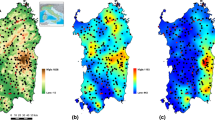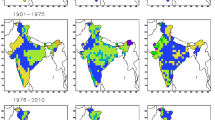Abstract
Often, an exploratory data analysis reveals that geostatistical data are not homogeneous over the region under study, and that their means, variances and/or correlation functions are different from one area to another. This paper proposes and illustrates a new methodology for the segmentation of a region into homogeneous areas, based on a criterion akin to the analysis of variance, but taking into account spatial correlations. This methodology is illustrated on simulated data and is used on a rainfall dataset from Switzerland to separate the region into homogeneous zones corresponding to low rain / high rain zones (rain fronts).
Access this chapter
Tax calculation will be finalised at checkout
Purchases are for personal use only
Preview
Unable to display preview. Download preview PDF.
Similar content being viewed by others
References
Allard, D. and Fraley, Ch. (1997) Non parametric maximum likelihood estimation of features in spatial point processes using Voronoϊ tesselation, Journal of the American Statistical Association 92,1485–1493.
Ambroise, C., Dang, M. and Govaert, G. (1995) Clustering of spatial data by the EM algorithm, in A. Soares et al (eds.), geoENV I — Geostatistics for Environmental Applications. Kluwer Academic Publishers, Dordrecht, pp. 493–504.
Besag, J. E. (1986) On the statistical analysis of dirty pictures, Journal of the Royal Statistical Society, Sen ? 48, 259–302.
Cressie, N. (1993) Statistics for Spatial Data, Wiley-Interscience, New-York.
Dempster, A. P., Laird, N. M. and Rubin, D. B. (1977) Maximum likelihood from incomplete data via EM algorithm (with discussion), Journal of the Royal Statistical Society, Sen ? 39, 1–38.
Geman, S. and Geman, D. (1984) Stochastic relaxation, Gibbs distribution and the Bayesian restoration of images, IEEE Transactions on Pattern Analysis and Machine Intelligence 6, 721–741.
Haslett, J. (1985) Maximum likelihood discriminant analysis on the plane using a Marko-vian model of spatial context, Pattern Recognition 18, 287–296.
Oliver, M. A. and Webster, R. (1989) A Geostatistical basis for spatial weighting in multivariate classification, Mathematical Geology 21,15–35.
Ripley, B. D. (1996), Pattern Recognition and Neural Networks, Cambridge University Press, Cambridge.
Searle, R. S., Casella, G. and McCulloch ?. ?. (1992), Variance Components, Wiley-Interscience, New-York.
Switzer, P., Kowalik, W. S. and Lyon, R. J. P. (1982) A prior probability method for smoothing discriminant analysis classification maps, Math. Geology 14,433–444.
Venables, W. N. and Ripley, B. D. (1994) Modern Applied Statistics with S-Plus, Springer-Verlag, New-York.
Wackernagel, H. (1995), Multivariate Geostatistics, Springer-Verlag, Berlin.
Author information
Authors and Affiliations
Editor information
Editors and Affiliations
Rights and permissions
Copyright information
© 1999 Springer Science+Business Media Dordrecht
About this paper
Cite this paper
Allard, D., Monestiez, P. (1999). Geostatistical Segmentation of Rainfall Data. In: Gómez-Hernández, J., Soares, A., Froidevaux, R. (eds) geoENV II — Geostatistics for Environmental Applications. Quantitative Geology and Geostatistics, vol 10. Springer, Dordrecht. https://doi.org/10.1007/978-94-015-9297-0_12
Download citation
DOI: https://doi.org/10.1007/978-94-015-9297-0_12
Publisher Name: Springer, Dordrecht
Print ISBN: 978-90-481-5249-0
Online ISBN: 978-94-015-9297-0
eBook Packages: Springer Book Archive




